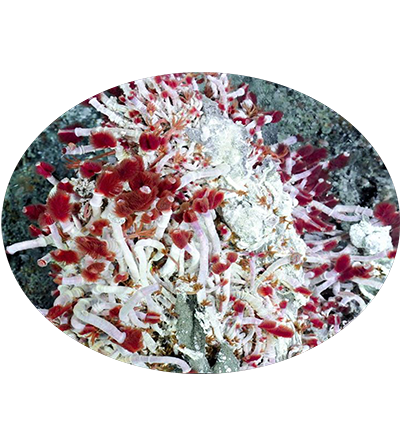
Ridgeia piscesae is a tube worm found in a variety of environments on the Juan de Fuca Ridge. Found in clusters up to several square meters in area, these Polychaete’s lack a digestive tract, instead taking up organic carbon from symbiotic, chemoautotrophic bacteria found in their specially-evolved trophosomes. These bacteria oxidize sulfur in order to create organic material. Initially thought to be several species of the Ridgeia genus on the Juan de Fuca Ridge, genetic comparison showed that only one species existed, with various morphologies. The two extreme morphologies are the so-called long-skinny and fat-short forms.
| Species | Phylum | Common Name | Ecosystem | Depth | Habitat | NCBI Taxonomy ID |
|---|---|---|---|---|---|---|
| Ridgeia piscesae | Annelida | tube worms | Hydrothermal vent | 2,196 | the Juan de Fuca Ridge (47°57.00′ N, 129°5.82′ W) | 27915 |
| Genome Assembly | Genome Size | Assembly level | Released year | WGS accession | Submitter | BioProject | BUSCO completeness | Gene Number |
|---|---|---|---|---|---|---|---|---|
| R07B-5 | 658.2Mb | Contig | 2022 | JAODUO01 | Universite de Montreal | PRJNA786438 | 94% | 31,703 |
| ASM2569855v1 | 574.96Mb | Scaffold | 2022 | JALOCR01 | Third Institute of Oceanography, Ministry of Natural Resources, PRC | PRJNA826206 | 91.70% | 24,096 |
| Title | Journal | Pubmed ID |
|---|---|---|
| Third-Generation Sequencing Reveals the Adaptive Role of the Epigenome in Three Deep-Sea Polychaetes | Molecular Biology and Evolution | 37494294 |
| The genome of a vestimentiferan tubeworm (Ridgeia piscesae) provides insights into its adaptation to a deep-sea environment | BMC Genomics | 36774470 |
| Gene ID | Description |
|---|---|
| KAK2181992.1 | |
| KAK2181993.1 | ACTIN |
| KAK2181994.1 | DIMETHYLARGININE DIMETHYLAMINOHYDROLASE |
| KAK2181995.1 | |
| KAK2181996.1 | SUPPRESSOR OF ACTIN MUTATIONS 2/VACUOLAR PROTEIN SORTING 52 |
| KAK2181997.1 | 30S RIBOSOMAL PROTEIN S13/40S RIBOSOMAL PROTEIN S18 |
| KAK2181998.1 | RAB GTPASE-ACTIVATING PROTEIN 1-LIKE |
| KAK2181999.1 | |
| KAK2182000.1 | RAB GTPASE-ACTIVATING PROTEIN 1-LIKE |
| KAK2182001.1 | PEPTIDYL-PROLYL CIS-TRANS ISOMERASE |
| KAK2182002.1 | |
| KAK2182003.1 | CASEIN KINASE II SUBUNIT BETA |
| KAK2182004.1 | DNA POLYMERASE EPSILON SUBUNIT 3 |
| KAK2182005.1 | - |
| KAK2182006.1 | PROTEIN CBG24663 |
| KAK2182007.1 | REVERSE TRANSCRIPTASE DOMAIN-CONTAINING PROTEIN |
| KAK2182008.1 | UBIQUITIN-LIKE PROTEIN 5 |
| KAK2182009.1 | PROTEIN CBG26694 |
| KAK2182010.1 | |
| KAK2182011.1 | |
| KAK2182012.1 | |
| KAK2181962.1 | |
| KAK2181963.1 | SPONDIN |
| KAK2181964.1 | |
| KAK2181965.1 | UNCHARACTERIZED |
| KAK2181966.1 | |
| KAK2181967.1 | |
| KAK2181968.1 | DIHYDROPYRIMIDINE DEHYDROGENASE [NADP(+)] |
| KAK2181969.1 | DIHYDROPYRIMIDINE DEHYDROGENASE [NADP(+)] |
| KAK2181970.1 | WD40 REPEAT PROTEIN |
| KAK2181971.1 | HYPOXIA-INDUCIBLE FACTOR 1 ALPHA INHIBITOR-RELATED |
| KAK2181972.1 | |
| KAK2181973.1 | COLLAGEN ALPHA |
| KAK2181974.1 | COLLAGEN ALPHA |
| KAK2181975.1 | |
| KAK2181944.1 | ENDO-1,4-BETA-GLUCANASE |
| KAK2181945.1 | ENDO-1,4-BETA-GLUCANASE |
| KAK2181946.1 | ALKALINE PHOSPHATASE |
| KAK2181947.1 | |
| KAK2181948.1 | PROKARYOTIC DNA TOPOISOMERASE |
| KAK2181949.1 | PROKARYOTIC DNA TOPOISOMERASE |
| KAK2181950.1 | PROKARYOTIC DNA TOPOISOMERASE |
| KAK2181951.1 | PROKARYOTIC DNA TOPOISOMERASE |
| KAK2181952.1 | FATTY ACID DESATURASE 2 |
| KAK2181953.1 | UBIQUITIN-CONJUGATING ENZYME E2 |
| KAK2181954.1 | DNAJ HOMOLOG SUBFAMILY C MEMBER 7 |
| KAK2181955.1 | LONG-CHAIN-FATTY-ACID--COA LIGASE |
| KAK2181956.1 | |
| KAK2181957.1 | |
| KAK2181958.1 |

